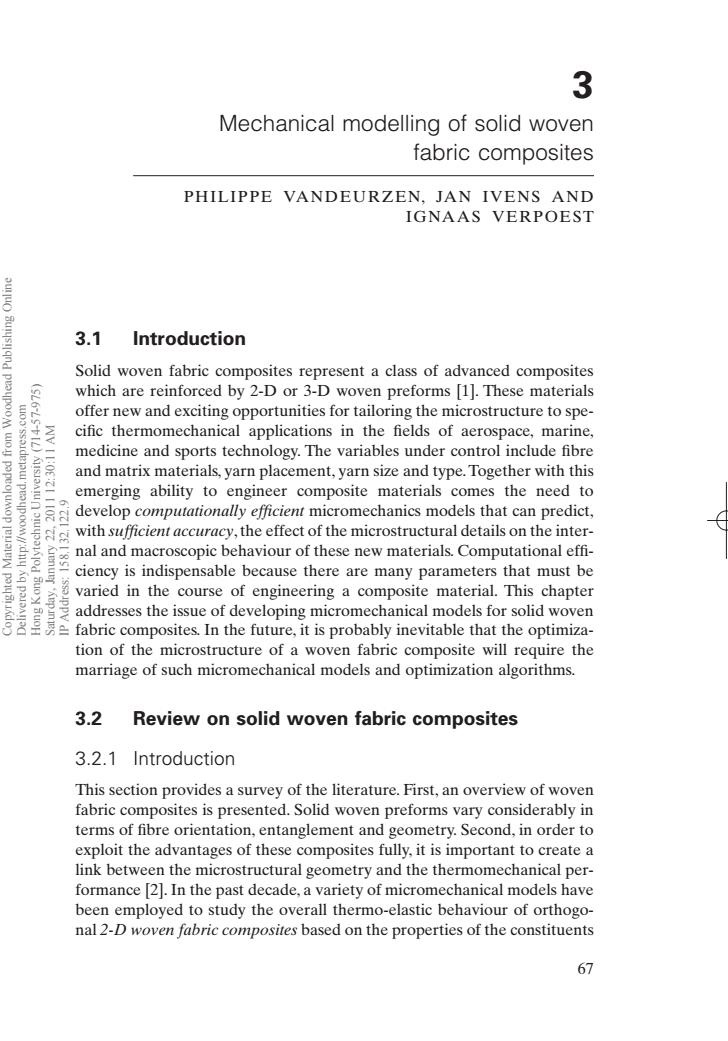正在加载图片...

3 Mechanical modelling of solid woven fabric composites PHILIPPE VANDEURZEN,JAN IVENS AND IGNAAS VERPOEST 3.1 Introduction Solid woven fabric composites represent a class of advanced composites which are reinforced by 2-D or 3-D woven preforms [1].These materials offer new and exciting opportunities for tailoring the microstructure to spe- cific thermomechanical applications in the fields of aerospace,marine, L:0 medicine and sports technology.The variables under control include fibre and matrix materials,yarn placement,yarn size and type.Together with this ahiuin emerging ability to engineer composite materials comes the need to develop computationally efficient micromechanics models that can predict, with sufficient accuracy,the effect of the microstructural details on the inter- nal and macroscopic behaviour of these new materials.Computational effi- ciency is indispensable because there are many parameters that must be mposites In the future.it is probably inevitable that the varied in the course of engineering a composite material.This chapter addresses the issue of developing micromechanical models for solid woven tion of the microstructure of a woven fabric composite will require the marriage of such micromechanical models and optimization algorithms. 3.2 Review on solid woven fabric composites 3.2.1 Introduction This section provides a survey of the literature.First,an overview of woven fabric composites is presented.Solid woven preforms vary considerably in terms of fibre orientation,entanglement and geometry.Second,in order to exploit the advantages of these composites fully,it is important to create a link between the microstructural geometry and the thermomechanical per- formance [2].In the past decade,a variety of micromechanical models have been employed to study the overall thermo-elastic behaviour of orthogo- nal 2-D woven fabric composites based on the properties of the constituents 673.1 Introduction Solid woven fabric composites represent a class of advanced composites which are reinforced by 2-D or 3-D woven preforms [1]. These materials offer new and exciting opportunities for tailoring the microstructure to specific thermomechanical applications in the fields of aerospace, marine, medicine and sports technology. The variables under control include fibre and matrix materials, yarn placement, yarn size and type. Together with this emerging ability to engineer composite materials comes the need to develop computationally efficient micromechanics models that can predict, with sufficient accuracy, the effect of the microstructural details on the internal and macroscopic behaviour of these new materials. Computational effi- ciency is indispensable because there are many parameters that must be varied in the course of engineering a composite material. This chapter addresses the issue of developing micromechanical models for solid woven fabric composites. In the future, it is probably inevitable that the optimization of the microstructure of a woven fabric composite will require the marriage of such micromechanical models and optimization algorithms. 3.2 Review on solid woven fabric composites 3.2.1 Introduction This section provides a survey of the literature. First, an overview of woven fabric composites is presented. Solid woven preforms vary considerably in terms of fibre orientation, entanglement and geometry. Second, in order to exploit the advantages of these composites fully, it is important to create a link between the microstructural geometry and the thermomechanical performance [2]. In the past decade, a variety of micromechanical models have been employed to study the overall thermo-elastic behaviour of orthogonal 2-D woven fabric composites based on the properties of the constituents 3 Mechanical modelling of solid woven fabric composites PHILIPPE VANDEURZEN, JAN IVENS AND IGNAAS VERPOEST 67 RIC3 7/10/99 7:37 PM Page 67 Copyrighted Material downloaded from Woodhead Publishing Online Delivered by http://woodhead.metapress.com Hong Kong Polytechnic University (714-57-975) Saturday, January 22, 2011 12:30:11 AM IP Address: 158.132.122.9